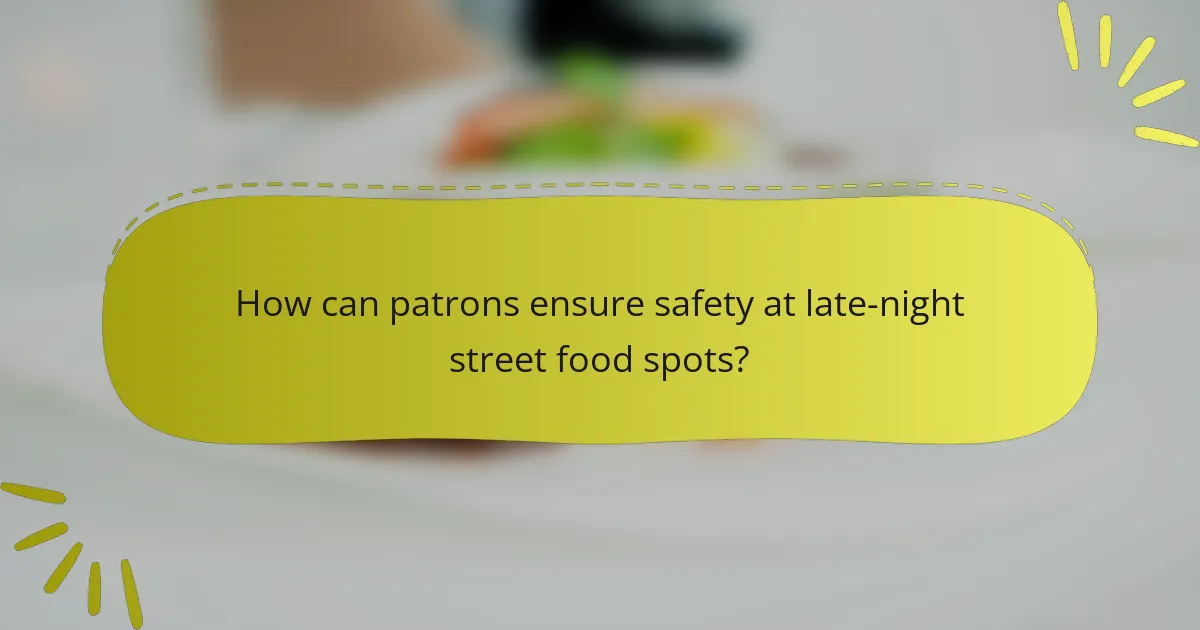Late-night street food spots are vendors that offer a variety of quick and affordable meals during nighttime hours, commonly found in urban areas with high foot traffic. Popular offerings include tacos, kebabs, and hot dogs, catering primarily to nightlife crowds such as bar-goers and event attendees. The article explores the significance of location convenience, popular menu items, and essential safety tips for patrons. Key practices for ensuring safety at these food spots include choosing clean vendors, observing food preparation, and prioritizing cooked items. Additionally, factors such as social ambiance and customer service quality contribute to the overall experience at late-night street food locations.

What are late-night street food spots?
Late-night street food spots are locations that offer food for sale during nighttime hours. These spots typically feature a variety of quick and affordable meals. Common offerings include tacos, kebabs, and hot dogs. They are often found in urban areas with high foot traffic. Many late-night street food vendors cater to nightlife crowds, including bar-goers and event attendees. These spots provide convenience for those seeking late-night snacks. In some cities, they are a cultural staple, reflecting local cuisine. Safety and hygiene practices can vary among vendors, so consumers should choose wisely.
Why do people choose late-night street food spots?
People choose late-night street food spots for their convenience and accessibility. Many late-night food vendors operate in busy areas, making them easy to find. These spots often cater to individuals looking for quick meals after late-night events. Popular items include snacks and comfort food that satisfy late-night cravings. The affordability of street food is another appealing factor for many customers. Additionally, the vibrant atmosphere of late-night food markets attracts social interactions among diners. Street food often provides unique local flavors that are not available in traditional restaurants. The availability of diverse food options makes these spots appealing to a wide range of tastes.
What cultural factors influence the popularity of late-night street food?
Cultural factors influencing the popularity of late-night street food include social interactions and urban lifestyle. In many cultures, street food serves as a social hub where people gather. It fosters community connections and shared experiences. Additionally, late-night street food often reflects local culinary traditions. This authenticity attracts both locals and tourists. Convenience is another key factor; late-night options cater to those seeking quick meals after events. Economic factors also play a role, as street food is often more affordable than restaurant dining. Lastly, cultural acceptance of late-night eating varies, influencing its prevalence in different regions.
How do late-night street food spots cater to different tastes and preferences?
Late-night street food spots cater to different tastes and preferences by offering a diverse range of food options. They typically feature various cuisines, including local specialties, international dishes, and fusion foods. This variety allows customers to choose based on their cravings and dietary restrictions. Many vendors provide vegetarian, vegan, and gluten-free options to accommodate different dietary needs.
Additionally, these spots often adjust their offerings based on seasonal ingredients and local trends. The presence of customizable menu items, such as build-your-own tacos or bowls, further enhances personalization. Street food vendors also adapt to regional flavors, ensuring that their offerings resonate with local palates.
Research indicates that food diversity is a key driver for customer satisfaction in street food markets. A study by the Journal of Culinary Science & Technology highlights that variety in food choices increases customer engagement and repeat visits.
What are the typical locations of late-night street food spots?
Typical locations of late-night street food spots include busy urban areas, nightlife districts, and near entertainment venues. These spots often thrive in places with high foot traffic. Areas around bars, clubs, and concert venues are common. Food trucks and stalls may also be found near late-night transportation hubs. Popular locations include city squares and parks that host evening events. Additionally, college campuses often have late-night food options to cater to students. Research indicates that convenience plays a key role in the success of these food spots.
How does location convenience impact the success of late-night food vendors?
Location convenience significantly impacts the success of late-night food vendors. Vendors positioned near high foot traffic areas, such as bars and clubs, attract more customers. A study by the National Restaurant Association found that 70% of late-night diners prefer food options within walking distance. Proximity to public transportation also enhances accessibility. Vendors in well-lit, safe areas tend to experience higher sales. Additionally, convenience influences customer decisions, as people often prioritize nearby options when hungry late at night. Thus, strategic location selection is crucial for maximizing a vendor’s potential success.
What neighborhoods are known for their late-night street food offerings?
Chinatown in many cities is known for its late-night street food offerings. Areas like Los Angeles and New York City have vibrant food scenes after dark. In Los Angeles, street vendors serve tacos and elotes late into the night. New York’s Chinatown features dumplings and bao from food carts. The Mission District in San Francisco is famous for its burritos, available late at night. Additionally, Koreatown in Los Angeles offers a variety of Korean BBQ options. These neighborhoods are popular for their diverse and accessible late-night food choices.
What popular items can be found at late-night street food spots?
Popular items at late-night street food spots include tacos, hot dogs, and kebabs. Tacos are often filled with various meats and toppings. Hot dogs are typically served with condiments like mustard and ketchup. Kebabs feature grilled meat on skewers, often accompanied by vegetables. Other common offerings are burgers, fried rice, and dumplings. These items are favored for their quick preparation and satisfying flavors. Street food culture thrives on convenience and affordability, making these items accessible to night owls.
What are the most common types of food served at these spots?
The most common types of food served at late-night street food spots include tacos, hot dogs, and kebabs. Tacos are popular for their variety and quick preparation. Hot dogs are a classic choice, often served with various toppings. Kebabs offer a filling option, typically made with grilled meat and vegetables. Other common items include burgers, fries, and sandwiches. These foods are favored for their convenience and affordability. They cater to late-night crowds looking for quick and satisfying meals. Many street vendors also serve local specialties, enhancing the cultural experience.
How do seasonal ingredients influence the menu at late-night food vendors?
Seasonal ingredients significantly influence the menu at late-night food vendors. Vendors often adjust their offerings based on the availability of fresh produce. This practice enhances flavor and quality, appealing to customers seeking unique tastes. Seasonal ingredients can also reduce costs, as they are typically more abundant. For instance, summer may feature fresh corn and tomatoes, while winter could highlight root vegetables. By incorporating these ingredients, vendors can create limited-time specials that attract repeat customers. Research indicates that menus with seasonal items see increased sales due to heightened consumer interest. This strategy not only promotes local agriculture but also fosters a connection between the vendor and the community.

How can patrons ensure safety at late-night street food spots?
Patrons can ensure safety at late-night street food spots by following several key practices. First, they should choose vendors with a clean and organized setup. Cleanliness indicates proper food handling and hygiene standards. Second, patrons should observe food preparation processes. Watching how food is cooked can help identify safe practices. Third, they should prioritize vendors with a high customer turnover. A busy vendor often signifies fresh food and higher safety standards. Fourth, patrons should avoid raw or undercooked items. Consuming fully cooked food reduces the risk of foodborne illnesses. Fifth, they should carry hand sanitizer for personal hygiene. This is especially important when soap and water are not available. Lastly, patrons should trust their instincts. If a food spot feels unsafe or unsanitary, it’s best to walk away. Following these practices enhances safety while enjoying late-night street food.
What safety tips should be considered when visiting late-night street food spots?
When visiting late-night street food spots, prioritize your safety by following specific tips. Choose well-lit and populated areas to reduce risks. Ensure the food vendor maintains cleanliness and proper hygiene practices. Observe the cooking process to confirm that food is prepared fresh. Avoid consuming food that has been sitting out for long periods. Keep your belongings secure and be aware of your surroundings. Trust your instincts; if something feels off, leave the area. Use cashless payment methods when possible to minimize theft risk. These precautions help ensure a safe and enjoyable experience at late-night street food spots.
How can patrons assess the cleanliness of a street food vendor?
Patrons can assess the cleanliness of a street food vendor by observing several key factors. First, they should examine the vendor’s food preparation area for visible dirt or debris. A clean workspace indicates good hygiene practices. Second, patrons can look for the presence of handwashing stations. Access to soap and water is essential for food safety. Third, they should check if the vendor uses gloves or utensils to handle food. This minimizes direct contact and contamination risks. Fourth, patrons can assess the condition of food storage containers. Properly sealed and labeled containers suggest cleanliness. Lastly, they can observe the vendor’s personal hygiene. Clean clothing and grooming reflect a commitment to sanitation. These factors collectively provide a reliable indication of the vendor’s cleanliness and food safety standards.
What precautions should be taken regarding food allergies?
Individuals with food allergies should take specific precautions to ensure their safety. Always read ingredient labels carefully before consuming any food. Inform food vendors about your allergies when ordering. Ask about cross-contamination practices in food preparation. Carry an epinephrine auto-injector if prescribed by a doctor. Avoid foods that are known allergens, even in small amounts. Educate friends and family about your allergies for support. It’s essential to have a plan for allergic reactions, including knowing emergency contact numbers. These steps help prevent allergic reactions and ensure a safer dining experience.
What role does local health regulation play in street food safety?
Local health regulation is crucial for ensuring street food safety. It establishes standards for food preparation, handling, and storage. These regulations help prevent foodborne illnesses by requiring vendors to follow hygiene practices. Inspections by local health authorities enforce compliance with these standards. According to the Centers for Disease Control and Prevention, proper regulation can reduce the incidence of food-related outbreaks. Additionally, regulations often mandate training for food handlers on safe food practices. This creates a safer environment for consumers. Overall, local health regulations play a vital role in maintaining food safety in street food settings.
How can patrons verify if a vendor complies with health standards?
Patrons can verify if a vendor complies with health standards by checking for health inspection certificates. Vendors are typically required to display these certificates prominently. Patrons should look for the most recent inspection date and the overall rating. Additionally, patrons can inquire about the vendor’s food handling practices. Observing the cleanliness of the vendor’s setup and equipment is also important. Research shows that vendors with visible compliance measures tend to have higher food safety ratings. Local health department websites often provide inspection records for vendors. This data can confirm a vendor’s compliance history.
What are common health violations to look out for at street food spots?
Common health violations at street food spots include improper food handling practices. This can lead to cross-contamination between raw and cooked foods. Insufficient food temperature control is another violation. Foods must be kept at safe temperatures to prevent bacterial growth. Poor personal hygiene among food handlers is also a concern. Handwashing facilities should be available and used frequently. Additionally, unclean cooking and serving equipment can pose health risks. Regular inspections reveal that many street food vendors fail to meet these hygiene standards. According to the FDA, improper food handling contributes to foodborne illnesses.

What factors influence the experience at late-night street food spots?
The experience at late-night street food spots is influenced by several factors. Location convenience plays a critical role. Easily accessible spots attract more customers. Popular items on the menu also enhance the experience. High demand for specific dishes can create a lively atmosphere. Safety concerns impact customer choices. Well-lit areas and visible vendor hygiene practices improve perceptions of safety. Social ambiance contributes to the overall experience. Crowded spots often create a sense of excitement. Customer service quality is another important factor. Friendly interactions can lead to repeat visits.
How does the atmosphere affect the enjoyment of late-night food?
The atmosphere significantly influences the enjoyment of late-night food. A vibrant and lively setting enhances the overall dining experience. Factors such as lighting, music, and crowd energy contribute to a positive ambiance. For example, dim lighting can create a cozy environment, making food feel more inviting. Additionally, upbeat music can elevate mood and encourage social interaction. Research shows that people enjoy food more in stimulating environments, as it heightens sensory experiences. In contrast, a dull or chaotic atmosphere can detract from the enjoyment of food. Overall, the right atmosphere can transform late-night dining into a memorable experience.
What elements contribute to a vibrant late-night street food scene?
A vibrant late-night street food scene is characterized by diverse food offerings, accessibility, and a lively atmosphere. Diverse food offerings attract a wide range of customers. Popular items often include local specialties and comfort foods. Accessibility is crucial; locations should be easy to reach and open late. A lively atmosphere includes music and social interactions among patrons. Safety measures, such as well-lit areas and clean food preparation, enhance the experience. Community engagement through events can also boost popularity. These elements combined create an appealing environment for late-night diners.
How can patrons engage with vendors to enhance their experience?
Patrons can engage with vendors by actively communicating their preferences and questions. This interaction helps vendors tailor their offerings to meet customer tastes. Patrons can also provide feedback on their experiences, promoting better service and food quality. Engaging in conversations about ingredients or preparation methods enriches the dining experience. Additionally, patrons can participate in social media promotions or loyalty programs offered by vendors. This engagement fosters a sense of community and connection. Studies show that positive vendor-patron interactions lead to increased customer satisfaction and repeat business.
What are the best practices for enjoying late-night street food safely?
To enjoy late-night street food safely, prioritize cleanliness and vendor reputation. Choose vendors with high traffic and visible food preparation areas. Ensure food is cooked thoroughly to the appropriate temperatures, which is typically above 165°F. Avoid raw or undercooked items, as they may harbor bacteria. Observe food handling practices; vendors should wear gloves and maintain hygiene. Drink bottled or sealed beverages to avoid contamination. Pay attention to food storage; hot foods should be kept hot and cold foods cold. Lastly, trust your instincts; if something seems off, it’s best to skip it.
What should patrons keep in mind when trying new vendors?
Patrons should consider food safety and vendor reputation when trying new vendors. Ensuring the vendor follows hygiene practices is crucial. Look for clean preparation areas and well-maintained equipment. Check for food handling certifications if available. Customer reviews can provide insights into the vendor’s quality. Popular items often indicate a vendor’s reliability. Observe the vendor’s busy times; high foot traffic usually suggests good food. Trust your instincts; if something seems off, it’s best to avoid the vendor.
How can planning ahead improve the late-night street food experience?
Planning ahead enhances the late-night street food experience by ensuring better choices and reduced wait times. Knowing the popular food stalls in advance allows for quicker decision-making. This preparation helps avoid long lines at busy vendors. Research indicates that peak hours for street food often lead to overcrowding. By selecting a less busy time, diners can enjoy a more relaxed atmosphere. Additionally, planning can help identify specific dishes that are highly recommended. This increases the likelihood of a satisfying meal. Overall, preparation leads to improved satisfaction and enjoyment of the late-night street food scene.
Late-night street food spots are urban locations offering quick and affordable meals during nighttime hours, catering primarily to nightlife crowds. This article explores the convenience of these food vendors, popular items such as tacos and kebabs, and the cultural factors that influence their appeal. It also highlights safety tips for patrons, including how to assess vendor cleanliness and ensure food safety. Additionally, the article discusses the impact of location on vendor success and the diverse food options available to meet various dietary preferences.